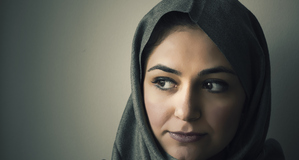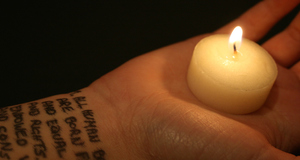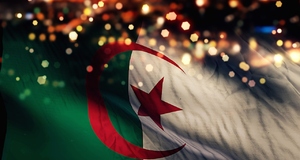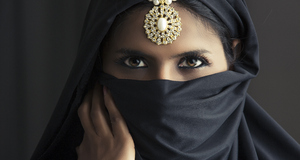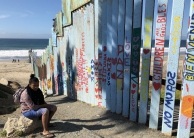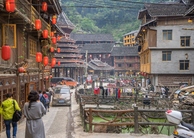Featured Article:Mob Violence Against Women in Algeria: A Historical Case Analysis
By
2015, Vol. 7 No. 03 | pg. 1/3 | »
IN THIS ARTICLE
KEYWORDS
AbstractViolence against women has recently become well recognized as a violation of human rights that holds worldwide significance. Unfortunately, violence against women outside of North America has gone largely unnoticed among the academic community and the media. Algerian citizens have seen this failure to acknowledge violent incidents targeting women as a simplistic representation of underlying problems facing Algerian women in local communities. This paper applies Marshall and Stockes’ (1981) Schematic Presentation of Political Contingencies in an effort to identify historical and cultural contributions to the recent incidents of gender-specific mob violence in Algeria. This systematic approach outlines the various contributions to the incidents of mob violence in Algeria and the multiple complex factors that are grounded within social, political, and legal developments. The purpose of this paper is to examine incidents of violence against women outside of North America. Focus is directed toward the gender specific mob attacks targeting women that began July 13th, 2001 in the Algerian city of Hassi Messaoud. In order to understand the cultural construction of gender within this country, the socio-economic and political history of the region is reviewed. An important historical turning point in Algeria was the implementation of the Algerian Family Code in 1984 (Bennoune, 1995). The law enacted under this code has been described as a contributing factor in the first reported incidents of mob attacks against women, the Hassi Messaoud mob attacks, and the spread of gender specific mob violence within the country thereafter (Salhi, 2003). 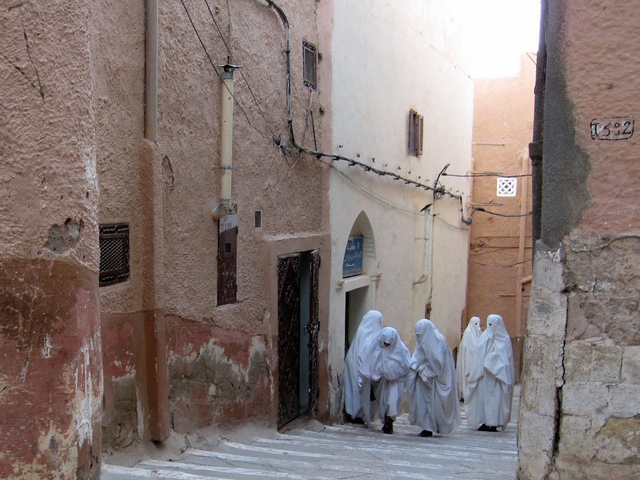
Conservatively shrouded Algerian women. Photo: Stefan Krasowski CC-2 Meanwhile, the rise of the women’s movement in Algeria is increasingly involved in emerging acts of resistance, fighting to give women agency (Bouatta, 1997). Randall Stokes and Susan Marshall’s Schematic Presentation of Political Contingencies, developed in 1981 as a way to analyze different government policies that affect the status of women, provides a framework for understanding current incidents of gender specific mob violence in Algeria. This model identifies the significance of Algeria’s colonial penetration (through elite fragmentation and ethnic revitalization) as important factors that have contributed to the country’s political instability. Furthermore, this instability created an elite reliance on traditionally rooted ideologies causing the amplification of traditional order which is an important element in the social construction of Algerian women, and incidents of violence against them (Stokes & Marshall, 1981). In order to properly understand current incidents of mob violence against women in Algeria, we must first look at the historical construction of this society (Holt, 2003). Throughout history the configuration of women in Algeria has been subject to great changes in light of the country’s independence movements that began in 1954 (Horne, 2012; Quandt, 2004). The War of Independence was fought between French colonists and the Algerian citizens, in which Algerian citizens fought for the re-establishment of social, democratic and sovereign power of the state based on the principles of Islam (Cohen, 2000; Faksh, 1997). Historically, the war in Algeria brought women and men together to fight for human rights, representing the progressive actions that occurred during an anti-colonial struggle (Zack, 2002). When the war occurred, women fought side by side with men and were considered equal participants in the struggle for equality (Abu-Haidar & Amrane, 1999). This created a new sense of identity for many female citizens as differences based on gender were put aside to fight for the greater good of the country (Horne, 2012). In 1962, the war in Algeria ended when a peace agreement was signed with the French acknowledging that Algeria was an independent country (Cohen, 2000; Glasse, 2008). After the war most women fighting for the rights of their country returned to more traditional roles within the home (Horne, 2012). These roles were based on previously established social gender divisions (i.e. roles and classes), placing women within the home (Abu-Haidar & Amrane, 1999; Afary, 1997). In 1963, Ahmed Ben Bella was elected as president causing Algeria to develop into a Socialist country (Holm, 2005; Mortimer, 1991). As a result of Algeria becoming a socialist country, the 1960’s–1970’s, gave rise to capitalism (globalization) within Algeria causing economic and socio-political changes (Bourouh, 2004; Metz, 1994). These changes caused complex social problems and reduced Algeria’s social conditions (Majumdar & Saad, 2005). The economic and socio-political changes in Algeria resulted in the 1980’s economic crises riot as well as the proliferated protests and acts of violence by citizens against the government and country (Holt, 2003; Joffé, 2002). Currently, economic and socio-political issues continue to affect Algeria’s overall social conditions (i.e. economic and political) and threaten the safety of many Algerian citizens (Roe, 1992). The financial difficulties faced by this country led to significant problems for citizens and resulted in drastic cuts to essential social resource budgets in order to maintain larger economic growth (Moghadam, 2000; Metz, 1994). Socially and culturally constructed gendered norms and ideologies are affected by the constant cyclical destruction of Algeria’s economic development (Majumdar & Saad, 2005; Skalli, 2006). In other words, the volatility of the economy caused a rise in industrialization, restricting the resources needed for social programs directed towards promoting equality for women (Nagel, 1998; Skalli, 2006). With Algeria’s new government leaders, applying socialist principles to the construction of the country’s economy, women’s issues of gender equality were met with great opposition from conservative Islamic groups (Mayar, 1995; Moghadam, 2005). The complex history, customs and Islamic heritage within Algeria is a significant part of the Maghrib and Arab world (Carapico, 2002). The status of women, and their national identity, within Algeria, therefore, has been constructed from both past and present gendered customs (Glasse, 2008). A large portion of Algerians, both Arab and Amazigh, identify as being what is known as “Sunni Muslims of the Maliki rite” (Shinar, 2004, p. 268). The Algerian government (post-independent) often created policies encouraging secular developments and have long-established the Islamic heritage of their country (Stokes & Marshall, 1981). It is important to note the increasing strength of Islamic fundamentalism that grew in the 1970s, was in reaction to the government’s policies that were viewed as going against the greater good of Algerian citizens (Faksh, 1997; Shinar, 2004). Algerian citizen’s perceptions surrounding the government’s negative intentions caused continued citizen revolts. This affected the level of safety within various communities as they were targeting ‘inferior minorities’ (i.e. women, feminists and foreign workers/ immigrants) (Mortimer, 1996). Muslim extremist groups have been shown to sporadically clash with women's groups and left-wing students, while fundamentalist imams (prayer leaders) have continually influenced the country's major mosques (Moghadam, 2000). In Algeria, Islam is a practice based on traditional ethical attitudes and principles rather than acknowledging newly formed cultural ideologies (Faksh, 1997; Glasse, 2008). Despite pressures placed upon female citizens, women’s groups developed in the early 1980s (The Committee for the Legal Equality of Men and Women, the Algerian Association for the Emancipation of Women) (Metz, 1994). During this time women feared public scorn and government retaliation, decreasing the number of women who chose to participate in equal rights movements (Bouatta, 1997; Lloyd, 1999). The role of women, in the public realm, became evident to the government and, in response; they appointed the first female cabinet minister, in 1984 (Cheref, 2006; Mortimer, 1991). Although the government had taken a step toward acknowledging women’s rights, promising the development of new jobs for women, the economic crises quickly made this goal short lived (Bourouh, 2004; Charrad, 2001). Increased discouragement occurred within the secular regime due to traditional Islamist groups threatening the progress made within the women’s movement (Glasse, 2008). The Algerian Family Code (1984)The first introduction of the Family Code, in 1981, was implemented by the Algerian government and backed by support from Islamic conservatives (Lloyd, 2001; Woodhull, 1991). This Code established a set of legal provisions used to regulate the family, marriage and reflects views of some Islamic conservatives (Faksh, 1997; Salhi, 2003). It was immediately met with outrage and protests from over 700 women (Metz, 1994). The protests were based on women’s beliefs that the code was not sufficient in its reforms directed towards the rights of women (Kelly & Breslin, 2010). Protests and debates over the code caused the government to withdraw the proposal to make a more conservative revision. In 1984, the new Family Code was passed in order to prevent further protests by women (Jansen, 2004; Lloyd, 1999). Although changes were made, little was altered in respect to issues effecting women. Arguments from feminist scholars arose disapproving of how women only achieve legal independence after marriage while men, regardless of marital status, are considered independent at age eighteen (Charrad, 1990). This directly emphasized women’s inferior status as they were seen as being dependent on men (Salhi, 2003). After the introduction of the Family Code, the second version came into effect in 1984, and was largely based on Islamic Sharia law (Lloyd, 1999; Mir-Hosseini, 2006). Provisions present within the code were seen as discriminatory and facilitated violence against women by legitimizing men’s power over women’s rights (Holt, 2003). Human rights groups, within the country, found it difficult to deal with the consequences that arose due to the laws outlined within the code and the rising cruelties of Islamic terrorism (Bennoune, 1995; Salhi, 2003). Women were targeted in an effort to preserve male supremacy, by Islamic terrorists, leading to “sexist terrorism; femicide” (Salhi, 2003, p. 28). In Algeria the family is seen as the basic unit within society; controlled by the husband as he is entitled to the obedience of his wife (Charrad, 2001; Glasse, 2008). The rules presented within the Algerian Family Code placed unequal burdens on women, such as unequal inheritance of property (Jansen, 2004). Moreover, women were unable to marry without consent from their male guardians and were only granted divorce under certain conditions (Mir-Hosseini, 2006). Men, however, were allowed to divorce without justification and upon divorce men were granted the house and could immediately evict their children and wives (Abu-Haidar & Amrane, 1999). The Family Code brought backlash from women who were against influential Muslim clergies and government officials as they still opposed the emancipation of women (Holt, 2003; Moghadam, 1995). Differences in gender roles, in Algeria, have been separated into two societies as each represent a different set of values and attitudes (Nagel, 1998). Daily interactions are predominantly conducted between members of the same sex, creating social gender divisions (Miller, 1997; Nagel, 1998). Women without being accompanied by men were seen as disturbers of the established social order (Afary, 1997; Salhi, 2003). The enforcement of the Family Code has led to the constant threat of violence which was more prominent in the 1990s as women’s groups worked together to repel the Family Code (Salhi, 2003). Many Algerian women and children are becoming overrepresented within the homeless population (Marpsat, 2000). The amount of women being placed on the street has caused many of these women to break from traditional roles within the household in order for them to find jobs to support their families. Divorced women have found themselves living in the slums or seeking refuge in hostel organizations, such as SOS Women in Distress (Turshen, 2004). Due to the lack of funding placed in these types of social development projects; however, space is limited or unavailable to address the rising rate of homelessness among Algerian women (Mayar, 1995; Moghadam, 2005). These situations have caused women to be increased targets of mob violence by men who are trying to maintain or preserve the existing social order (Nagel, 1998). A Shift From Violence Against the State to Individual ViolenceOrdinary citizens have not always been a part of the mob or group attacks against women, in Algeria. The fundamentalist movement, originating in the 1970’s, gave rise to organized armed groups (i.e. GIA, AIS) focusing on the adherence to a strict set of ideas and principles (Hafez, 2000; Turshen, 2002). During this time fundamentalists organized politically by deploying targeted violence as a mechanism for imposing their agenda against female university students, women factory workers, single women living alone and feminist activists (Lloyd, 2006). Within the 1980’s, arson attacks committed against single women was often ignored, leading to no legal action taken on behalf of the state (Miller, 2011; Turshen, 2002). A substantial amount of political pressure was placed on the state by emerging fundamentalist groups, leading to the enactment of the Family Code (Jansen, 2004; Roe, 1992). In 1989, fundamentalist protests, against the government, led to the amendment of the Constitution to include consent to the formation of political parties (Hafez, 2000; Holt, 2003). This allowed the fundamentalists to unite under what was known as the FIS (Islamic Salvation Front) (Turshen, 2002; Mortimer, 1991). With new legal rights now being granted to the FIS troops they were entitled to run for the electoral control of municipalities. Even with laws supporting the FIS ideologies, they still continued to engage in the ‘political’ violence against women, escalating the violence within the country (Bouatta, 1997; Moghadam, 2005). Leaders of the FIS quickly declared an opposition to democracy and pushed for gender-apartheid (Nagel, 1998). In 1990, the FIS won the municipal elections and they were granted control over a vast amount of municipalities where they continued to fight for greater gender restrictions (Afary, 1997; Brumberg, 1991). The FIS used their social and legal positions to reinforce threats and violence on local women (Holt, 2003). The second phase of national legislative elections, in 1991, caused the FIS to escalate the attacks on women (Carapico, 2002; Hafez, 2000). In response to these attacks and increased forms of violence, the Algerian State banned the FIS from their governmental positions. Fundamentalists formed additional armed groups, known as The Armed Islamic Group (GIA), which attacked women who were seen as challenging the prescribed gender roles (Glasse, 2008; Nair, 1998). Female relatives of police, government, and security forces where the first groups of women brutally tortured, raped, and killed by the FIS after their full banishment from the government in 1992 (Brumberg, 1991; Lloyd, 2006). Other women were not safe either as these armed groups frequently raped, killed and abducted young women holding them captive as slaves (forcing them into what is known as Muta marriages) (Nair, 1998; Stone, 1997). The years of terror inflicted upon Algerian communities, as well as the imposed regulation of gender roles by the FIS, has left negative effects on the country’s policies pertaining to gender equality (Miller, 2011; Roe, 1992). Despite these incidents many sections within society continue to deliver strong modes of resistance to the fundamentalists’ agenda (Brumberg, 1991; Carapico, 2002). As a result, there has been a rise in leadership, feminist activism and women organizations fighting against these fundamentalists despite the risks of violence (Holt, 2003; Mayar, 1995). Even though forms of violence originated with the fundamentalist groups these ideologies have expanded to include ordinary citizens who are inspired by the teachings of the FIS and GIA (Masmoudi, 2003).Continued on Next Page » Suggested Reading from Inquiries Journal
Inquiries Journal provides undergraduate and graduate students around the world a platform for the wide dissemination of academic work over a range of core disciplines. Representing the work of students from hundreds of institutions around the globe, Inquiries Journal's large database of academic articles is completely free. Learn more | Blog | Submit Latest in Law & Justice |








